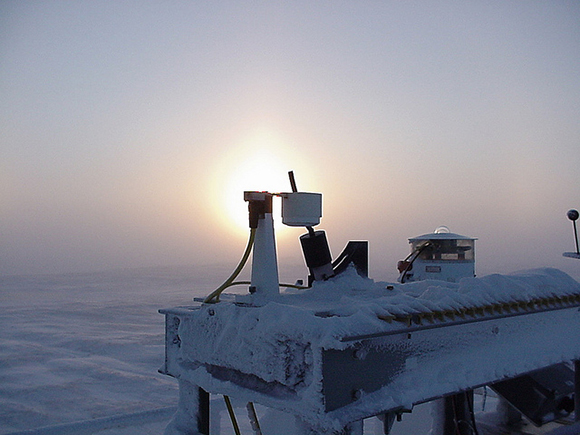Atmospher Sci & Global Chg
Research Highlights
December 2013
Polar Impress
Scientists improve detection of Arctic clouds

Caught in the early morning light, the multifilter rotating shawdowband radiometer instrument takes measurements of direct and diffuse sunlight in Barrow, Alaska. Now that PNNL scientists have devised a new method for screening out the thin clouds prevalent at this Alaska site, those measurements will be much more effective. Enlarge Image. Photo courtesy of the ARM Climate Research Facility.
Results: Thin Arctic clouds can no longer hide, thanks to scientists at Pacific Northwest National Laboratory. Atmospheric data gathered by skyward pointing instruments can be "contaminated" by clouds so wispy that they appear to the instruments as tiny, suspended particles called aerosols, the desired target. The researchers showed how a simple modification of typical methods used to detect denser clouds and remove them from the data results in more accurate measurements of aerosols. (See sidebar, Cloud Contamination and Cloud Screening). With these improvements, scientists can better understand how aerosols influence climate changes in the Arctic.
"Thin and almost uniform Arctic clouds are occasionally undetected by well-established methods," said Dr. Evgueni Kassianov, atmospheric scientist and lead author of the study. "Our research found a minor modification of these methods that substantially improves the detection of these clouds, thereby reducing cloud contamination of aerosol data sets."
Why It Matters: Sunbathers see clouds as an obstacle between them and the sun's bronzing rays. Scientists have a similar point of view when trying to capture atmospheric information from the ground by using instruments that point up. In some cases, the upward looking instruments require clear skies to gather the correct data. Clouds can hinder this requirement by blocking the instruments' view. To make matters worse, if the clouds are thin and wispy, these clouds may contaminate observations thought to have been made under clear sky conditions. In this study, the scientists were particularly interested in gaining information in the Arctic where thin clouds abound. The improved method proposed by these scientists will increase effectiveness of atmospheric measurements to understand possible abrupt climate changes in the Arctic.
Methods: Researchers at PNNL conducted an observational study based on a multi-year and integrated dataset of aerosol and clouds collected at the high-latitude Atmospheric Radiation Measurement (ARM) Climate Research Facility's North Slope of Alaska (NSA). Two sites provided data, one on the northern coast in Barrow, Alaska, and the second in Atqasuk, Alaska, about 100 kilometers inland from the coast. They documented occasional failures of the well-established cloud-screening methods, which had great success at other lower-latitude ARM facility sites (where the clouds are thicker and more opaque). The team uncovered the main reasons for such failures. They proposed and evaluated an improved version of these cloud-screening methods, which in turn led to improved aerosol climatology at the ARM Alaska sites.
What's Next? Researchers plan to apply the improved method to similar datasets collected at ARM sites globally. These extended applications will provide important observational constraints for model-based estimates of the aerosol impact on the Earth's radiation budget.
Acknowledgments
Sponsor: This research was funded by the U.S. Department of Energy Office of Science, Office of Biological and Environmental Research, Atmospheric Radiation Measurement (ARM) Climate Research Facility.
Research Team: Evgueni Kassianov, Connor Flynn, Annette Koontz, Chitra Sivaraman, and Jim Barnard at Pacific Northwest National Laboratory.
Research Area: Climate & Earth Systems Science
Reference: Kassianov E, C Flynn, A Koontz, C Sivaraman, and J Barnard. 2013. "Failure and Redemption of Multifilter Rotating Shadowband Radiometer (MFRSR)/Normal Incidence Multifilter Radiometer (NIMFR) Cloud Screening: Contrasting Algorithm Performance at Atmospheric Radiation Measurement (ARM) North Slope of Alaska (NSA) and Southern Great Plains (SGP) Sites." Atmosphere 4(3):299-314. DOI: 10.3390/atmos4030299
